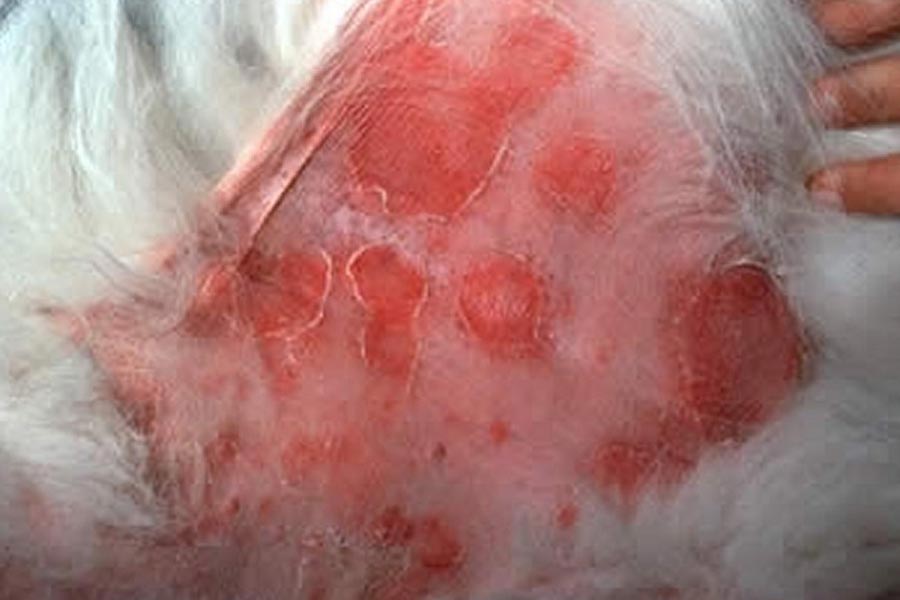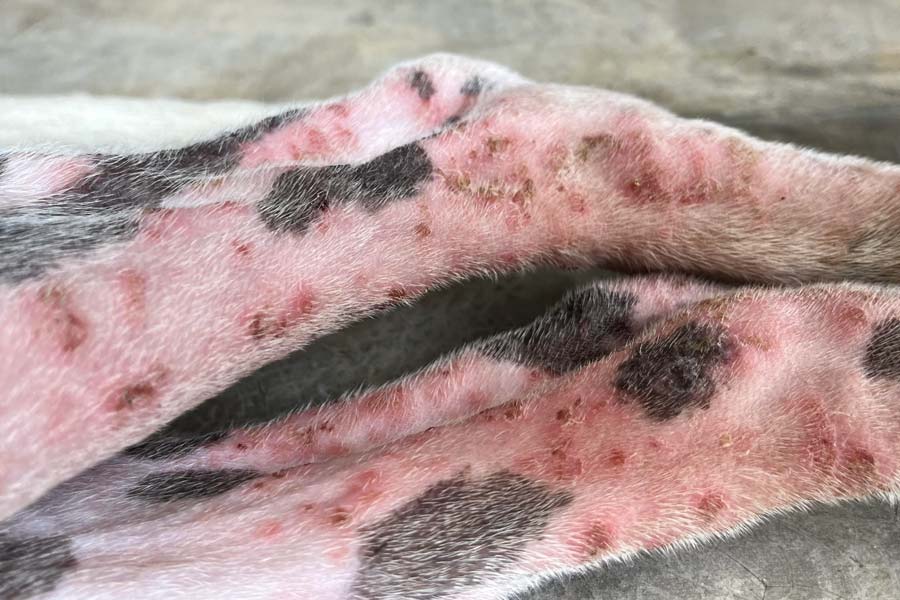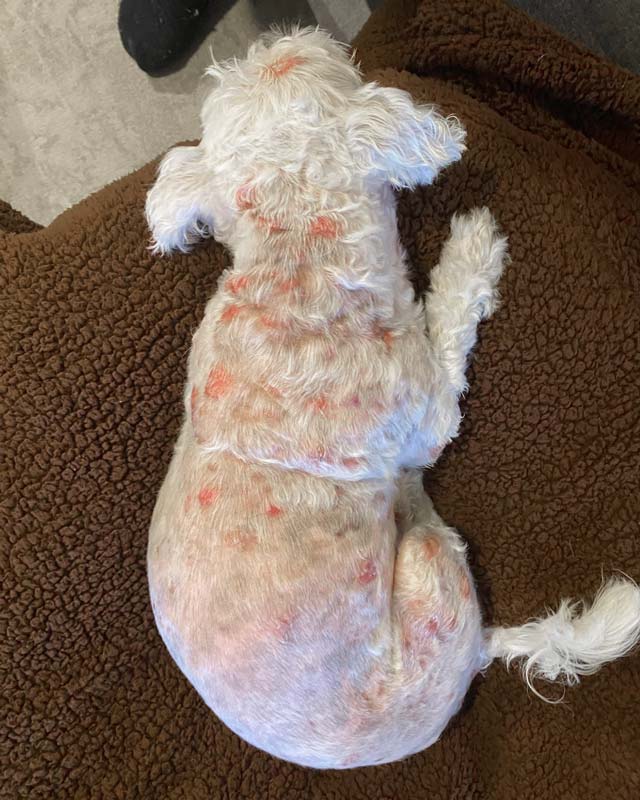Pyoderma: Pimples, Pustules, Impetigo + Bacterial Skin Infections in Dogs
Remember, this is an educational resource, not a guide for diagnosis.
Pictures are helpful, but they may not tell the whole dermatological story. We always recommend consulting with your vet for any of your dog's health concerns.

What is Pyoderma?
The term pyoderma means "pus in the skin," and it nearly always refers to a bacterial infection. It is predominantly caused by simple or complex bacterial infections.
Simple bacterial infections are brought about by one-time events, such as a scratch or hot spot. Complex infections are chronic and associated with underlying diseases or injury, such as skin allergies, severe burns, hormonal disorders, seborrhea, or parasites.
They are also often linked to wrinkly breeds that are prone to skin fold dermatitis (intertrigo).
It is possible for a secondary yeast infection to occur in addition to pyoderma, creating a compound infection.
Pyoderma is classified into 3 categories based on the infection's depth: surface, superficial, or deep.
Lavengel® Puts Pyoderma to Pasture

Surface Pyoderma
Surface pyoderma affects only the epidermis, the outermost layer of the skin. These tend to be mild, itchy, and the most treatable. Most hot spots (acute moist dermatitis) and skin fold infections (intertrigo) are considered forms of surface pyoderma.
Photo: Acute moist dermatitis on dog's leg; via r/holoVII on Reddit

Superficial Pyoderma in Dogs
Superficial pyoderma is the most common form that is seen in dogs, reaching deeper within the epidermis to the hair follicles. It is also the most common reason for antimicrobial use among small animal practices.
Warm, moist areas of the skin, such as skin folds, armpits, groin, and interdigital areas, as well as pressure points - like elbows and hocks (the "heel" of the hind leg) - tend to be more prone to developing superficial pyoderma. It often appears as pustules around hair follicles (folliculitis), hair loss (alopecia), round, red lesions with a flaky edge, and crusty, scaly skin. Impetigo in puppies is considered a form of superficial pyoderma.
Photo: Superficial pyoderma lesions on dog; by Stephen White, DVM; via the Merck Veterinary Manual

Deep Pyoderma
Pyoderma that involves the dermis - the layer of skin beneath the epidermis - and below is considered deep pyoderma. It is not as common as its superficial counterpart, but it is much more serious, as it brings a heightened risk of bacteria getting into the bloodstream (bacteremia). This can lead to a systemic infection that affects the entire body.
An area with deep pyoderma is often red, painful and sensitive, exhibiting crusting, bad odor, and discharging blood and pus. Acral lick granulomas, abscesses, and interdigital boils (furunculosis) are forms of deep pyoderma. Because these infections are more serious, they typically require both topical and systemic therapies (oral or injected) to clear the infection.
Photo: Lick granuloma with deep pyoderma, by Anthony Yu (V.A.D.E.R. Clinic); via Today's Veterinary Nurse
Key Identifiers of Pyoderma
- Red pustules, acne, or pimples filled with white or yellow pus
- Excessive scaling, crusty and flaky skin
- Discharge, blood, or pus may be present
- Swelling, blisters, redness, and scabs
- Excessive shedding and bald patches
- Welts around hairs (folliculitis)
- Foul odor is possible
- Itching, pain, and sensitivity

What Causes Pyoderma?
The vast majority of pyoderma cases are caused by bacteria called Staphylococcus pseudintermedius, which naturally dwells on canine skin. This species of Staph is a cousin to the Staph aureus that affects humans.
Like most opportunistic bacteria, 'Staph pseudi' is not inherently harmful until it can take advantage of a breach in the skin, set up a colony, and multiply - hence the term "opportunistic."
Canine pyoderma is often a secondary effect to skin damage. A breach in the skin can be caused by cuts, scrapes, or licking and scratching at itchy skin affected by:
- Allergy dermatitis
- Hot spots
- Flea or tick bites
- Mange mites
- Cheyletiella mites
- Bee stings
- General dryness
- Poor grooming
Dogs with weakened immune systems, autoimmune disorders, or those undergoing chemotherapy can have a greater risk of acquiring pyoderma. Hormonal (endocrine) conditions, such as Cushing's disease or hypothyroidism, can also render dogs more susceptible.
Photo: Dermatitis and lesions with superficial pyoderma, possibly caused by parasites; via r/DoYaFeelLuckyPunk on Reddit

Where Does Pyoderma Typically Occur?
Like an itch or wound, bacterial infections of the skin can happen anywhere on a dog's body. That said, there are certain areas that bacteria are more prone to dwell.
Warm, moist, and protected areas such as wrinkles and skin folds, armpits, between toes and paw pads, groin, or under the tail make for ideal locations for bacteria (and yeast) to thrive.
Breeds with loose skin and skin folds are at a higher risk of developing intertrigo (skin fold dermatitis) and bacterial infection, as the constant rubbing of skin disrupts the epidermal barrier and maintains a warm environment that microbes love.
Photo: Wound with possible bacterial infection, caused by scratching at allergy dermatitis
Dog Breeds Prone to Pyoderma
-
Shar Peis
-
German Shepherds
-
English Bulldogs
-
Frenchies
-
Basset Hounds
-
Pugs
How Is Canine Pyoderma Diagnosed?
Pyoderma is typically identified after a physical examination and a skin cytology. This involves collecting a sample of skin, hair, crust, pus, or other material about the lesion and examining it under a microscope.
Skin cytology helps rule out other causes of inflamed hair follicles (folliculitis), such as demodicosis (a form of mange) or dermatophytosis (ringworm). A skin cytology can also help point out if there is an abundance of Malassezia fungi (yeast) on the skin, which commonly pairs with Staph bacteria to form a compound infection.
Bacterial cultures (as well as fungal, if fungi are present) may also be taken for testing if pyoderma is recurrent or serious. This is especially important as antibiotic resistant infections are becoming more prevalent.
Finally, because pyoderma often arises due to an underlying problem, other diagnostic tests may be conducted to discover what is triggering the infection - whether allergies, endocrine disorders, parasites, or keratin disorders such as seborrhea. This is especially true in dogs that experience recurrent infections.

How Is Pyoderma Treated in Dogs?
Medicated shampoos, ointments, soaks, and antiseptic washes are common. Antibiotics - both oral and topical - are typically reserved for serious cases, as antibiotic resistance is a big concern, especially for dogs with recurrent cases.
A very viable ointment option is our own Lavengel®. Lavengel® has a U.S. patent for its ability to inhibit and counter Staphylococcus bacteria - both S. aureus in humans and S. pseudintermedius in dogs. Even their methicillin-resistant "superbug" forms (MRSA and MRSP) and their biofilms are highly susceptible to Lavengel®.
Lavengel® can not only help stop the infection, but also relieve sting and irritation that bacterial infections bring. And, because it's made with safe ingredients, it could be used in conjunction with other antibiotics.
Photo: Red lesions due to generalized bacterial infection, via r/Seeriee3 on Reddit
Pyoderma Prevention + Infection Protection
Bacteria do not hesitate to invade damaged skin. Thus, it's always a good idea to treat your dog's wounds quickly and keep an eye out for excessive licking, chewing, and scratching at a single area. Here are some other things you can do:
- Keep some Lavengel® on hand (obviously).
- Keep your dog's fur brushed and well-groomed.
- Bathe your dog regularly, being sure to wash those pits, ears, under the tail, and between toes and skin folds.
- Make sure they are thoroughly dry after bathing or being in water to prevent moisture from becoming trapped.
- Keep your dog's bedding and dishes clean.
- Make sure collars and harnesses aren’t too tight and allow appropriate air flow.
- Keep them on a flea prevention medicine, even during the cold months.
- If your dog has seasonal or environmental allergies, see your vet about an oral antihistamine regimen.
- Be aware of any food allergies your dog may have.
- Disallow them from agitating a specific spot; this may require booties, or an Elizabethan collar (cone).
Pyoderma in Dogs FAQs
Is dog pyoderma or a bacterial skin infection contagious?
It is rare that pyoderma is spread from dogs to humans, and good hygiene greatly minimizes the risk.
In nearly all cases, dogs develop pyoderma from a different species of Staphylococcus bacteria (S. pseudintermedius) than humans (S. aureus). It is possible, though very uncommon, for dogs to get an infection from S. aureus and humans to get an infection from S. pseudintermedius.
Humans, dogs, and other animals with weak or compromised immune systems are at a greater risk for contracting a bacterial infection.
What does pus in my dogs wound mean?
Pus is a by-product of the battle between the body's white blood cells and an invading bacterial species.
In other words, the area is infected, and you should seek treatment for your dog.
Will my dog's bacterial skin infection go away on its own?
While it is possible that a healthy dog's immune system can fend off minor skin infection, it is by no means a guarantee. Dogs that are older, puppies, or those that have a weakened immune system are at greater risk of the infection to spread.
Bacterial skin infections left untreated can irreparably damage the area and / or become systemic - meaning they get in the blood and move throughout the body. Systemic infections can create life-threatening consequences.
What bacteria causes pyoderma?
The vast majority of all cases of pyoderma in dogs are attributed to Staphylococcus pseudintermedius, a "cousin" to Staphylococcus aureus, which affects humans.
Is dog pyoderma deadly?
Pyoderma is rarely deadly for healthy dogs and is not considered a serious threat to life unless the infection is complex and/or systemic.
Dogs with weak immune systems, autoimmune disorders, or other underlying diseases will be at more risk of developing a dangerous bacterial infection.
Another factor is bacterial antibiotic resistance. If the bacteria have become completely resistant to antibiotics and the dog's immune system, the outlook becomes much more bleak.
Is it possible for my dog have both a bacterial and fungal infection?
Yes, a compound infection of bacteria and fungi is possible.
In fact, Malassezia yeast infections tend to develop in tandem with a bacterial infection. Identifying exactly which microbes are present using skin cytology is key for veterinarians to diagnose and treat single and compound infections.
Super Soothing Skin + Wound Salve for Dogs
Lavengel® is a powerful, soothing cream that quickly relieves irritated skin affected by hotspots, wounds, rashes, infections, bug bites, sores + more.
Free standard shipping on orders over $35
30-day money back guarantee
For every unit sold, we donate to help dogs + heroes








More Dog Dermatological Disorders
-

Yeast Infections
This yeast is preferred leastOften secondary to bacterial infections, yeast infections can spread quickly, itch severely, and result in fur loss and blotchy skin.
-

Dog Hot Spots
Too hot to handle?Hot spots, also called acute moist dermatitis, are a notorious (but treatable) skin issue that affects millions of pooches each year.
-

Atopic Dermatitis + Allergies
Atopic worth studyingAtopic dermatitis is caused by a overly-sensitive immune system reaction to an allergen that creates inflammation and itching in the skin.
Collapsible content
Resources on canine pyoderma + our patent
Lavengel® Patent on Google Patents:
U.S. Patent #10,912,759: Topical Gel Compositions for the Treatment of Staphylococcal Infections
From our blog:
Other resources:






